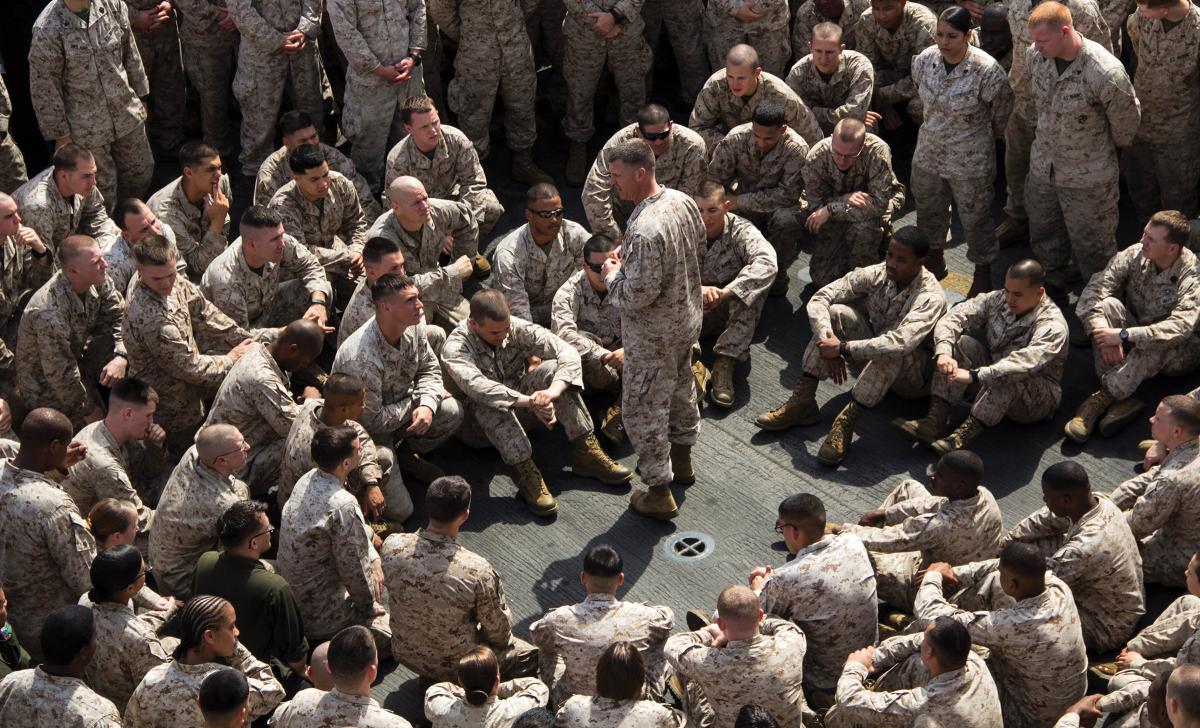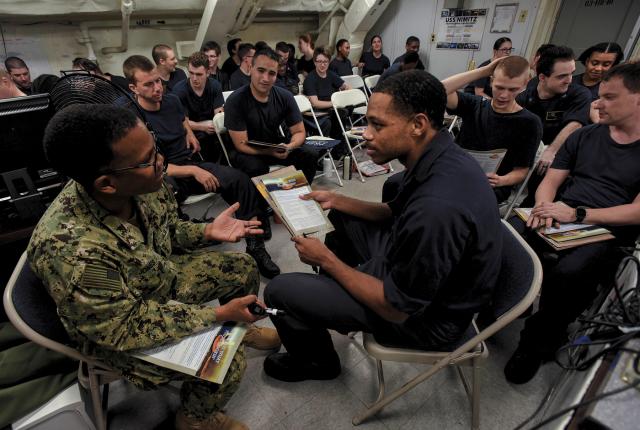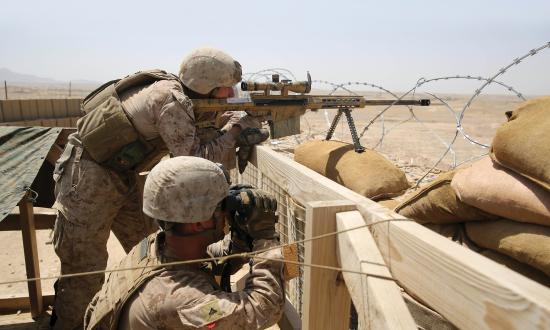Victory on future battlefields will depend as much on the character of U.S. Marines and sailors as it will on any other factor. One need look no further than the gross lapses of character at many levels that underpinned the behavior at the Abu Ghraib prison in 2004. Character requires more than the ability to obey orders. Virtue involves far more than just compliance. Yet too often leaders throughout the Department of the Navy attempt to impose good behavior on men and women without cultivating the character it necessitates. Briefings, memos, and addresses in formation are useful in communicating expectations, but they fall short of internalizing virtue. Virtue can be neither imposed nor extracted. It must be cultivated with the cooperation of the person involved.
Navy and the Marine Corps leaders must recognize how vital education is to the process of positive character transformation. Command Religious Programs (CRPs) are underused components of this education, and a robust CRP yields additional benefits for both commands and individuals.
Training Is Not Enough
Military leaders want their sailors and Marines to do the right thing at the right time. When they do not get the behavior they want, many assume the failure stems from a lack of knowledge. Briefings become the instrument for behavior modification. They assume their subordinates will receive this information, understand it as intended, and exercise the self-discipline to integrate it into their lives.
There are many reasons other than ignorance, however, that Marines and sailors violate standards. Often, they have not sorted out for themselves the perceived conflicts between their core values. A young Marine, for example, may have difficulty resolving conflict between loyalty to a fellow Marine and conformity with regulations when she sees her friend crossing the line into fraternization. Another possible reason for misconduct, a 2015 study by the U.S. Army Strategic Studies Institute reveals, is that servicemen and women feel they must resort to dishonesty because they are overwhelmed with requirements and are unable to prioritize effectively.1 Misconduct also might occur because many Marines and sailors have not yet adopted military standards as their own.
In the case where misconduct is the result of a lack of knowledge, the popular remedy—conveying information through formation—usually is ineffective. The Marine Corps’ practice of providing an “eight-day brief” in the wake of serious incidents reveals the limits of this approach. As chaplains, we see a large percentage of incidents occur within 48 hours of a brief designed to mitigate the very behavior that led to the mishap. Although documented differently in the Navy, the observation still holds true.
Most experts agree that the information retention rate of a passive learner is very low.2 In addition, what is retained may not be understood as intended. Consider the familiar Friday afternoon safety briefs in which leaders tell their Marines and sailors to “protect what they’ve earned” by drinking responsibly. But “drink responsibly” means different things to different people, and some interpretations inevitably will fall outside the realm of acceptable behavior. So, this overemphasis on passive training—which too often depends on passive learning, where the leader does most of the speaking and there is little interaction from the audience—results in lots of “rounds fired” (briefs given), but few “rounds on target” (improved behavior). Building character requires more than training and accountability; it requires education.
the USS Nimitz (CVN-68) can help build warfighting readiness as much as battlefield training. U.S. Navy (Emily Johnston)
Education Can Transform Character
Education differs from most standard military training in that it involves an interactive forum in which the leader invites audience participation and critical thinking. By no means is training unnecessary in character transformation; it simply is overused, while education is underused. Training and education must work hand-in-hand to yield character transformation. Marines are trained in boot camp, for example, to render instant obedience to orders. This training is unpacked and expanded during subsequent education at follow-on schools, such as the School of Infantry (SOI). The recruit depots train Marines to “do the right thing” at the right time; SOI teaches them to do it for the right reasons.
Shared experiences—expressed and rehearsed in a shared language—are critical to the learning and internalization process. The Navy directs all ranks to recite the Sailor’s Creed on a regular basis. It gives them a shared vocabulary and a set of common expressions around which they can build lives of honor, courage, and commitment. The Marine Corps’ legendary esprit de corps is not a product of training and accountability alone; it also comes from shared experiences, such as the grime of life in the field, the grit of the Marine Corps Martial Arts Program pit, and the annual celebration of the Marine Corps birthday.
Education also enhances character transformation because it gives sailors and Marines a forum to better understand both the “how” and “why” behind expected behavior. Interactive, honest discussions among leaders and subordinates help them process directives that may seem unclear or even contradictory. It also offers them a chance to conceptually grasp their responsibilities to one another and to the command, understand the larger impact of their choices, and learn from the mistakes of others.
This education need not erode command authority. Marines and sailors must obey lawful orders without hesitation or explanation. Marine Brigadier General Evans Carlson is an example of how effective education can be in character transformation. Hand-selected to lead a Raider battalion at the beginning of World War II, Carlson augmented his arduous training with what his men called weekly “Gung Ho” meetings. Carlson would gather his Marines together in an informal meeting to educate them on different philosophies of war. He made clear that they could ask him questions and voice concerns.3 This helped shape his Marines into a tough, smart, cohesive unit that believed in the mission and soundly defeated the Japanese at Makin Island and Guadalcanal. Training, when reinforced by education, can empower sailors and Marines to understand the reasons for the standards, adopt them as their own, and determine how the core values apply to real-life situations.
Chaplains Can Play A Vital Role
In that vein, U.S. Army Lieutenant Colonel Peter Kilner argues that “unit leaders provide the first line of defense against moral injury” to reduce its occurrence. Before deployment, Kilner says leaders should take every opportunity to integrate moral reasoning into tactical training and operations and that “chaplains and mental health professionals have important roles to play.”4
From the birth of the U.S. Navy, the chaplain’s role has included an educational program in support of both the individual and the command. Before the United States had a Naval Academy, it had chaplains on ships teaching sailors how to read, calculate, and navigate during the week and leading religious services on the weekends. From the very beginning, these CRPs have provided sailors and Marines with the life skills and moral education to succeed personally and professionally.
Life-skill classes taught by chaplains equip Marines and sailors to navigate life in the military, wrestle with their core values, and determine how to handle perceived conflicts between virtues. Religious services allow people of faith to draw strength from the Divine to be the person they are expected and aspire to be. Religious services and religious group studies create an ideal environment to discuss, consider, and discard poor choices. They reinforce the strengths and values of better decisions. Since most religions require community, these gatherings provide those who are struggling with an opportunity to change their behavior through advice, support, and accountability from other members of their faith, especially those in their respective commands.
CRPs also inspire Marines and sailors to rise above self-serving motives and teach them to do the right thing simply because it is the right thing to do. Most world religions call their followers to lives of virtue that honor the Divine, rather than for selfish gain. Virtually every world religion adheres to some version of the Golden Rule: Treat others as you want to be treated.5 Christians are called to think of and to act toward others as being more important than themselves (Philippians 2:3). One of the five pillars of Islam, Zakāt, gives clear guidance on how Allah expects Muslims to treat the less fortunate. In Judaism, the Ten Commandments clearly spell out how God expects his people to treat each other. This guidance provides objective standards that bring greater clarity to “what right looks like” than the fluctuating—and sometimes conflicting—cultural descriptions of a good person. For these reasons, leaders should view their CRPs as vital to developing and maintaining virtuous character in their crew and formations, even if they themselves are not religious.
Religious Program Benefits Are Broad
There are five additional ways a robust CRP can enhance individual Marines/sailors, their dependents, and the command.
1. Couples who attend religious services regularly are 46 percent less likely to get divorced compared with couples who do not attend religious services at all.6 Lower divorce rates enhance productivity and quality of life while reducing suicidal behavior.7
2. Research suggests that “men who attended religious services several times a week are 72 percent less likely to abuse their female partners than men of comparable backgrounds who did not attend services.”8 An active CRP, therefore, can help mitigate domestic violence.
3. Research also suggests that individuals who share a strong commitment to practicing their religion report the highest levels of well-being on average. Those who have a low commitment to practicing their religion have the lowest levels of well-being on average, even lower than those who are not religious.9 A dynamic CRP provides the structure for religious commitments to thrive.
4. Religious services allow sailors and Marines to find commonality between the expectations of the command and the will of the Divine. For those whose identification with the command and the military is weak, the CRP can help these wayward sailors or Marines connect to their faith and, in many cases, to their command.
5. Research strongly suggests that regular religious involvement lowers the rate of moral injury among combat veterans.10 These findings not only are relevant to the immediate issue of reducing misconduct and promoting virtue, but also offer long-range improvements to retention and even performance in combat.
Religious Programs Build Warfighting Readiness
In light of CRPs’ many benefits to individual sailors and Marines and to their commands, Sea Service leaders should support their CRP. They should encourage their chaplains to add religious services and life-skills classes to the operational schedule and then deconflict these events with other evolutions so service members can attend without missing work. Leaders also should explain to subordinate leaders how instrumental the CRP is to the desired behavior and well-being of their Marines and sailors. In addition, leaders should supply chaplains and lay leaders with locations and supplies for religious services. Leaders can support those who are not religious by offering character-focused education at the same time as religious services.
Chaplains, in turn, have a responsibility to execute a CRP that seizes every opportunity to offer religious services, life-skills classes, and character-focused education that reaches the greatest number of Marines and sailors with the most relevant information. This should include recruiting, training, and employing lay leaders and volunteers. They must be willing to flex with the operational schedule. Chaplains must help their Marines and sailors connect the demands of the moment with the timeless truths and principles that are the foundation of virtue in both war and peace.
Commands that are intentional about the character education of their sailors and Marines will prepare them to be victorious on the battlefield and in life. A key component of this education should be a well-supported Command Religious Program.
1. Stephen Gerras and Leonard Wong, “Lying to Ourselves: Dishonesty in the Army Profession,” U.S. Army War College Strategic Studies Institute, 5–9, ssi.armywarcollege.edu/pdffiles/pub1250.pdf.
2. Joseph DiPiro, “Why Do We Still Lecture?” American Journal of Pharmaceutical Education 73(8):137 (December 17, 2009): 1, ncbi.nlm.nih.gov/pmc/articles/PMC2828296/.
3. MAJ Kathleen Gomrick, USMC, “Gung Ho Raider! The Philosophy and Methods of Brigadier General Evans F. Carlson, Marine Corps Raider,” master’s thesis (Air Command and Staff College, 1999), 14, 15, 25, 36, dtic.mil.
4. LCOL Peter Kilner, USA (Ret.), “How Leaders Can Combat Moral Injuries in Their Troops,” Association of the United States Army, 17 April 2017, ausa.org/articles/leaders-combat-moral-injury.
5. Sir John Templeton, Wisdom from World Religions: Pathways toward Heaven on Earth (Conshohocken, PA: Templeton Foundation Press, 2002), 8.
6. Andrew Francis and Hugo Mialon, “A Diamond Is Forever and Other Fairy Tales: The Relationship Between Wedding Expenses and Marriage Duration” (University of Singapore, 2014), 8, papers.ssrn.com.
7. U.S. Department of Defense, Department of Defense Suicide Event Report CY 2011–2016 (Washington, DC: Defense Suicide Prevention Office, 2011–2016), dspo.mil/Prevention/Data-Surveillance/DoDSER-Annual-Reports/.
8. Christopher Ellison, et al., “Race/Ethnicity, Religious Involvement and Domestic Violence,” Violence against Women 13, no. 11 (November 2007): 1105, www.researchgate.net/publication/5893332.
9. Daniel Mochon, Michael Norton, and Dan Ariely, “Who Benefits from Religion?” Social Indicators Research 101, no. 1 (March 2011):1–15, hbs.edu/faculty/Pages/item.aspx?num=40219.
10. Harold Koenig, M.D., et al., “Moral Injury and Religiosity among U.S. Veterans with Post Traumatic Stress Disorder Symptoms,” Journal of Nervous and Mental Disease 206, no. 5 (May 2018): 328–29.






